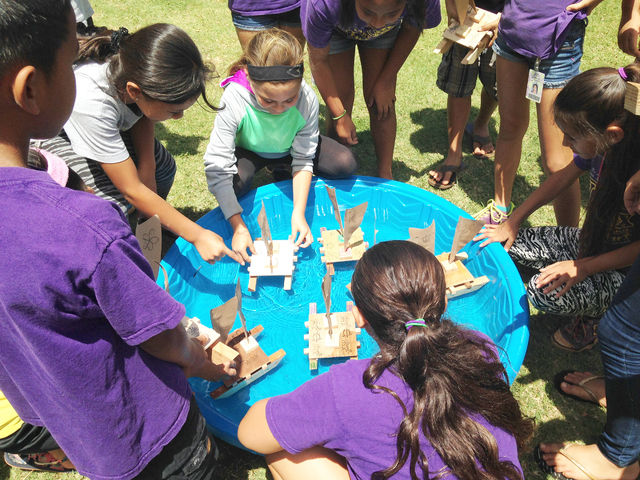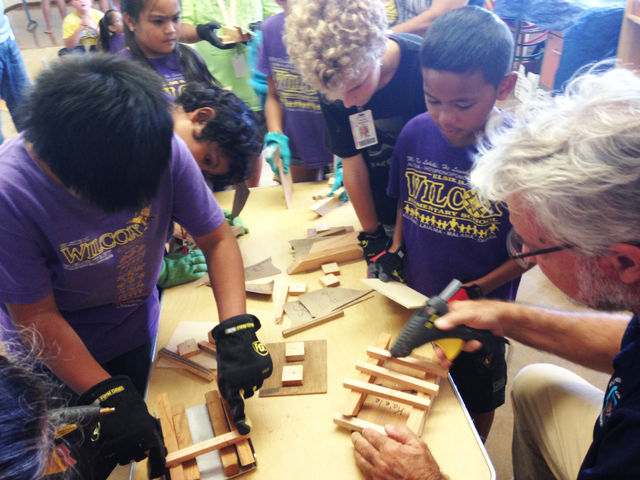LIHUE — Steve Soltysik says watching keiki get excited about building their own model wa’a has been the most rewarding part of his 46-year teaching career. “I enjoy being able to connect the joy of learning with Hawaiian culture,” he
LIHUE — Steve Soltysik says watching keiki get excited about building their own model wa’a has been the most rewarding part of his 46-year teaching career.
“I enjoy being able to connect the joy of learning with Hawaiian culture,” he said.
Soltysik, who has lived on Kauai for 30 years, sailed on the Hokulea, an ancient Hawaiian deep sea voyaging canoe in 1996. Last year, he sailed on the Gershon II, an escort boat for the Hokulea, from Brazil to the American Virgin Islands.
“I feel so fortunate and honored to be involved with the Worldwide Voyage of the Hokulea,” he said.
The Worldwide Voyage of the Hokulea began in 2013 with a voyage of the Hawaiian Islands. Since then, the ship has gone to Bali, South Africa, the Caribbean and the U.S. East Coast.
In addition to sailing on the Hokulea, Soltysik, a U.S. Coast Guard sea captain, uses his expertise to teach the upcoming generations about the history and traditions of Hokulea and wa’a, through the Keiki Wa’a Project.
For over three years, he has gone into fourth-grade classrooms around the island, teaching students about the canoe’s voyage.
He also guides students through assembling their own wa’a model, which is made out of 10 pre-cut pieces of reclaimed wood. Soltysik estimates he has made over 4,000 wa’as.
“I really believe in the values of the voyage — malama, lokahi and laulima — and this is a way to bring those values to the kids,” he said.
Of the values, Soltysik says malama is the most important.
“It’s about taking care of themselves and others,” he said. “I hope they learn malama and become good people.”
Building the wa’a model represents malama because it shows them how to care for something, Soltysik said.
“If they can take care of a canoe, they can take care of themselves,” he said. “That translates into taking care of their family.”
Soltysik was at Wilcox Elementary School Thursday and Friday, giving a presentation to the six fourth-grade classes.
He focuses on fourth grade because part of the year’s curriculum is Hawaiian culture, values and history.
“My goal is to reach every fourth-grade classroom on the island every year,” he said.
At the end of the presentation, the students are given the chance to float their wa’as in a pool.
On Friday, Zaiah Michael, a fourth grader at Wilcox Elementary, was excited to see if her wa’a floated.
“I can’t wait to float it,” she said. “Hopefully it does.”
Blaze Arzadon was also excited to watch his waa take off.
“I want to see if I can make it do a black-flip,” he said.
Once the wa’as are constructed, it’s up to the teachers what they want to do with them, Soltysik said.
“It’s something tangible that can be used in other subjects,” he said. “This project is like a hook to capture students’ interest.”
For example, teachers can use the dimensions of the wa’a for a math class, or use the wa’as to point to the country on a map the students will be learning next.
“It’s like a launchpad,” he said.
The reclaimed wood used to make the wa’as is donated from Home Depot and other companies. The wood is then cut into the right pieces by Kauai Community Correctional Center inmates, Soltysik said.
“For a lot of the inmates, this is the first time they get do so something of value, which is important,” he said. “I’ve seen some inmates really get into it, especially if they have children of their own.”
Because of the time and labor donations, the total cost of the project is a couple pennies, he said.
Asia Balbin, another fourth grader, said Friday she enjoyed the class.
“It was really educational,” she said. “I was surprised to learn the Hokulea sailed to New Zealand and Japan.”



